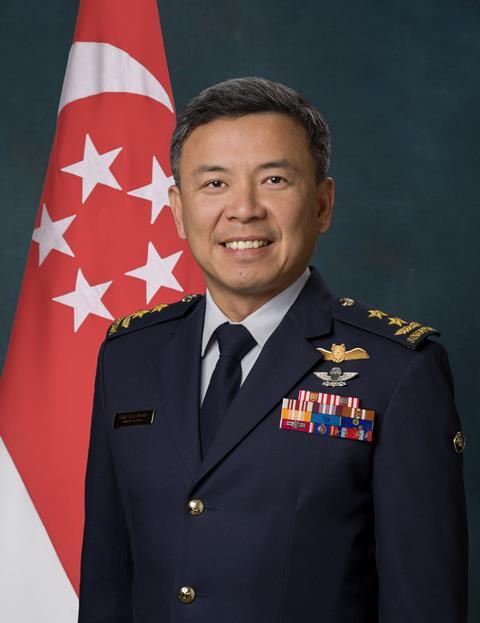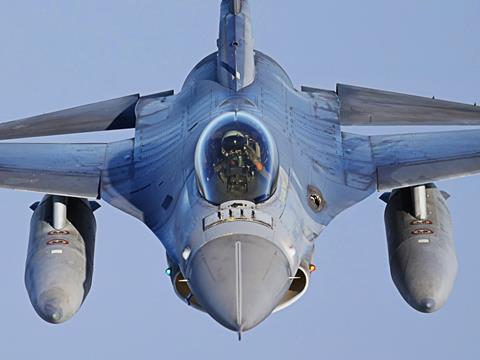Singapore’s top air force leader says that that Russia’s invasion of Ukraine highlights the continued importance of airpower in modern warfare, as the nation looks to upgrade existing platforms and introduce new aircraft.
“The Russia-Ukraine conflict has reinforced the importance of achieving air superiority,” says Major General Kelvin Khong in an emailed interview with media on the eve of the Singapore air show.

“I believe that if either side had achieved air superiority, the conflict would have taken on a very different trajectory. There is a higher probability that it would not have been so long and protracted.”
Although Russia has an ostensibly superior air force, it has been largely neutralised by Ukraine’s air defence capabilities, which include legacy Russian-designed systems and new Western-supplied equipment. Similarly, Ukraine’s small air force has been unable to fully support army units fighting on the frontlines.
The lack of decisive airpower on either side has led to a grinding, high-attrition conflict.
“I believe recent conflicts have reinforced the importance of cross-domain and cross-service integration,” adds Khong.
“In battles where air forces have freedom of action and where air power is tightly integrated with forces on the ground, we see successful outcomes. On the other hand, where air power is absent, or where air power is not well integrated with other domains, the outcomes are less desirable.”
Khong adds that the conflict has seen the rise of what he calls the “air littoral”, characterised by small, low-cost unmanned air vehicles, including first-person-view weapons that operators fly directly into targets. While such innovations can be effective for a time, they can be quickly countered in a cycle of rapid innovation.
Khong also touched on the Republic of Singapore Air Force’s (RSAF’s) upgrade acquisition plans.
Singapore will receive four Lockheed Martin F-35Bs in 2026, with the remaining eight it has on order to follow in subsequent years. It has plans to start training pilots for the type, as it continues to monitor the broader programme.
“Training will begin in the United States so that we can leverage the vast airspace to hone our operational skills and air combat readiness and allow us to have enhanced joint training and exchanges with the US forces,” says Khong.
Meanwhile, Singapore’s programme to upgrade about 60 Lockheed F-16C/Ds to the F-16V standard is “progressing well”, with some upgraded assets deployed with the RSAF’s Peace Carvin II detachment at Luke AFB in Arizona.
The updated fighters will gain a new active electronically scanned array radar in the form of the Northrop Grumman APG-83 as well as other improvements. Khong says the F-16 fleet will serve into the 2030s.

Khong hints that Singapore’s Boeing F-15SGs could also receive enhancements, although he does not offer specifics.
“The F-15SGs have been serving us well since 2009, and they are expected to continue to meet our operational needs,” he says.
“Nonetheless, we will continue to review our platform capabilities and refresh them when necessary and opportune to meet our operational requirements.”
Singapore officially says it has 24 F-15SGs but is widely believed to have 40 examples.
Boeing has said that it is in talks with legacy operators of the F-15 about possible upgrades that benefit from its work on the F-15EX.
Khong adds that Singapore will undertake a life-extension programme on its Boeing AH-64D Apache attack helicopters, pushing their retirement date “beyond 2030”. Cirium fleets data suggests that Singapore has 18 in-service Apaches.
In addition, Khong says the RSAF’s Lockheed C-130 tactical transports, Fokker 50 maritime patrol aircraft, and Gulfstream G550 airborne early warning and control aircraft continue to perform their missions.
“Notwithstanding, we continually monitor the systems’ performances and when necessary, we will refresh, upgrade or replace the capabilities to meet our mission needs,” says Khong.
While well maintained, the RSAF’s 10-strong C-130 fleet has an average age of 50.8 years. Embraer, which is displaying its C-390 transport at the Singapore air show for the first time, likely sees an opportunity in the city state.
“The RSAF will continue to build on the transformation that has brought us from the Cessnas in 1968 to the modern fleet that we operate today,” adds Khong.
“We must recognise the strength in our people and organisation, provide them with training and skills necessary to excel in a dynamic and unpredictable security environment and never lose sight of our primary mission to defend Singapore’s skies.”


























